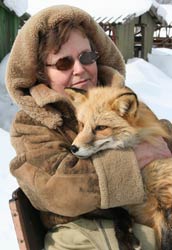Domesticated foxes provide insight into human behavior
July / August 2011 | Volume 10, Issue 4
By Steve Goldstein
What is tame? How does wild become domesticated? Would a fox wagging its tail as you approach it convince you that breeding can change biology? These are some of the questions that Russian scientist Dr. Lyudmila Trut hoped to answer, as well as a larger one: what could research with the fabled "sly" member of the Canidae family mean for humans?

Photo by Nadezhda P. Glebova
Dr. Lyudmila Trut has been
working with foxes for 50 years.
Trut works in Novosibirsk in southern Siberia with the world’s only population of domesticated foxes. Several years ago, she received a Fogarty International Research Collaboration Award (FIRCA) grant to work on the genetic architecture of the silver fox, building on previous studies demonstrating that domestication of foxes involves the acquisition of the ability to interpret human intent from facial expressions and body language of humans.
"The silver fox, as a recently domesticated mammal, offers a rich resource for studying complex patterns of interactive behavior," said Trut. "Tame and aggressive strains of fox we’ve developed have retained consistent but distinct behavioral phenotypes for several decades and multiple generations. The tame strain exhibits friendly, playful behavior like that of canine puppies."
Trut and her collaborators have published seven papers in the past two years, including the recent "On the origin of a domesticated species: identifying the parent population of Russian silver foxes" in the Biological Journal of the Linnean Society. Her work was prominently featured in the March issue of National Geographic.
The relevance to public health is the belief that this characteristic would help shed light on behavioral problems in humans such as autism. The inability to recognize human intent is one of the major components of autism. Trut’s research investigates the fox model for deciphering the genetic basis for recognition of human intent. Preliminary evidence identified four locations of genes on a DNA sequence that regulates behavior.
The research traces its history back more than 50 years to the Institute of Cytology and Genetics in Novosibirsk. As a young graduate student in 1958, Trut traveled to fur farms to locate the calmest foxes she could find. At the fox farm, they bred those most amenable to human contacts. Through generations, foxes began to show the "domestication phenotype."
But the collapse of the Soviet Union caused scientific funds to dwindle, just as the research was focusing on the ability to trace the domestication connection to foxes’ DNA. At risk was this rare population of domesticated silver foxes.
After Trut received her FIRCA grant, she was joined by Dr. Anna Kukekova, a Russian-born postdoc in molecular genetics at Cornell who’d read about Trut’s struggles and got a grant from the National Institute of Mental Health to go to Siberia. "Although these fox strains have been carefully studied for several decades, only recently has it become possible to consider a systematic approach to identify the loci and molecular mechanisms controlling complex interactive behaviors," said Kukekova.
Kukekova is working to link tame behavior to genes, but as she notes the task of locating the genes related to social behavior is monumental given that over 14,000 genes are expressed in the brain.
"Behavior is inherently complex, reflecting the response of an individual to its environment as mediated by multiple interacting, genetic, endocrine and neurologic mechanisms," Trut explained. "Despite this complexity, distinctive behavioral phenotypes are consistently observed in humans and other mammals, including many human behavioral disorders and the impaired social reciprocity characteristic of autism."
More Information
To view Adobe PDF files,
download current, free accessible plug-ins from Adobe's website.
Related Fogarty Programs